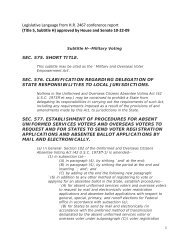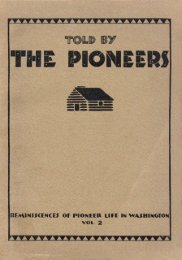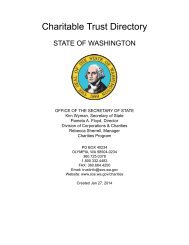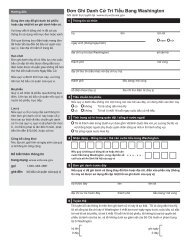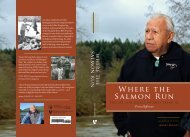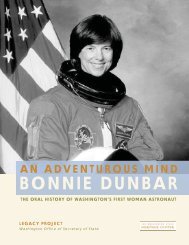TOLD by the PIONEERS - Washington Secretary of State
TOLD by the PIONEERS - Washington Secretary of State
TOLD by the PIONEERS - Washington Secretary of State
Create successful ePaper yourself
Turn your PDF publications into a flip-book with our unique Google optimized e-Paper software.
Told <strong>by</strong> <strong>the</strong> Pioneers<br />
THE ROUNDUP ON TOPPENISH CREEK<br />
Alexander McNeill<br />
Benton County<br />
Where Toppenish now stands, we had a big roundup for <strong>the</strong> reservation<br />
in 1882. All <strong>the</strong> cattle wearing <strong>the</strong> ID brand had to be cut out<br />
from <strong>the</strong> o<strong>the</strong>r brands and sent to <strong>the</strong> government farm. There were<br />
about 125 white men and 300 Indians in <strong>the</strong> roundup.<br />
A calf yearling came in ·with <strong>the</strong> ID or Indian Department brand,<br />
but its mo<strong>the</strong>r was one <strong>of</strong> <strong>the</strong> Burnham Huntington cows. 'Vill South,<br />
a Huntington man, roped this calf and started to drag it out and rebrand<br />
it. An Indian ran up and cut <strong>the</strong> rope. South struck at <strong>the</strong> Indian<br />
with a knife, but missed him and struck <strong>the</strong> Indian's horse, raklng<br />
it from <strong>the</strong> point <strong>of</strong> <strong>the</strong> hip to <strong>the</strong> tail bone. Then <strong>the</strong> fight started.<br />
Indians and white men pulled knives and six-shooters. My experience<br />
with Indians was just beginning and ano<strong>the</strong>r fellow named<br />
Parton was green, too. ,Ve debated whe<strong>the</strong>r we should mix in, but<br />
in <strong>the</strong> excitement pulled our guns and rode in to take part.<br />
Just <strong>the</strong>n Henry Allen, <strong>of</strong> <strong>the</strong> Allen and Snipes Company, rode up<br />
and ordered <strong>the</strong> men apart. The Indians withdrew, and we started<br />
our bands out toward <strong>the</strong> Bickleton country. The Indians' cattle had<br />
all been cut out and turned over to <strong>the</strong>m, but <strong>the</strong>y followed us clear<br />
out <strong>of</strong> <strong>the</strong> valley, annoying us in every possible way.<br />
FROJI MEMOIRS OF CHARLES O. SPLAWN<br />
Yakima County<br />
A good illustration <strong>of</strong> <strong>the</strong> vicissitudes which attended <strong>the</strong> journeys<br />
with cattle to <strong>the</strong> mining districts during <strong>the</strong> early days is furnished<br />
<strong>by</strong> <strong>the</strong> experience <strong>of</strong> Leonard Thorpe, one <strong>of</strong> <strong>the</strong> oldest living pioneers<br />
<strong>of</strong> Yakima County, who relates <strong>the</strong> following story:<br />
On February 14, 1866, Jack Splawn and I left <strong>the</strong> Moxee with 160<br />
head <strong>of</strong> fine beef cattle bound for <strong>the</strong> mines <strong>of</strong> British Columbia and<br />
Montana. ".,.e were both in our early twenties <strong>the</strong>n. Outfitted with<br />
•<br />
good saddle horses, blankets and o<strong>the</strong>r pioneer equipment, and accompanied<br />
<strong>by</strong> a friendly Indian whose name was <strong>Washington</strong>, we<br />
commenced with light hearts and buoyant spirits what was destined<br />
to be, for me at least, a most unfortunate trip. We drove east across<br />
<strong>the</strong> ridge to <strong>the</strong> Columbia, striking that river at White Bluffs. Here<br />
we swam <strong>the</strong> cattle and horses to <strong>the</strong> far<strong>the</strong>r shore without accident.<br />
122



